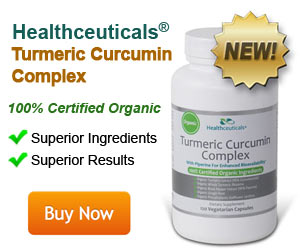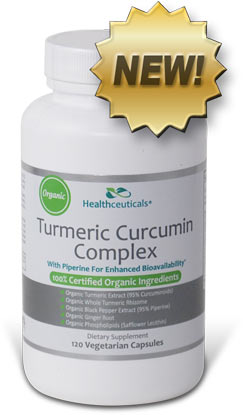Effects of Turmeric Compounds in Parkinson's Disease

The most well-studied turmeric compound is curcumin. Research indicates that the turmeric compound curcumin can prevent many of the steps that lead to Parkinson's disease. Both turmeric and curcumin may also help fight off severe flu — which has recently been linked to increased risk of developing Parkinson's. (iv.3-4, 6, 8, 10-11, 30-33, 103-107)

Figure IV.18: Effect of Curcumin on Parkinson's Disease
Curcumin Helps Balance Brain Chemicals & Protect Brain Cells
Curcumin promotes the heat shock response and stimulates the vitagenes HO-1 and Hsp-70. In turn this increases production of the body's own antioxidants and helps defend the brain from free radical damage. (iv.1, 5, 8, 39, 46)
Some scientists caution that too much HO-1 can lead to iron deposits in the cells damaged in Parkinson's disease. However, animal studies show that curcumin only induces protective amounts of it. Whole turmeric also contains resveratrol, vitamin C, and quercetin — all of which can help regulate HO-1 production. Lab studies indicate that curcumin also increases levels of the body's own potent natural antioxidant enzyme, superoxide dismutase (SOD). (iv.1, 5, 8, 39, 46)
Prevents Mitochondria Damage
Research indicates that curcumin directly protects mitochondria from damage. Experts suggest that dysfunctional mitochondria may be the main contributor to the development of Parkinson's disease. When mitochondria are dysfunctional, not enough cell energy is produced to maintain normal brain function. It also means the levels of antioxidants and free radical become unbalanced. Lab and animal studies demonstrate that curcumin protects toxic changes to the mitochondrial membrane and cell energy production because it: (iv.1, 8)
- Stimulates production of natural antioxidants.
- Blocks activation of the inflammatory transcription factor NF-κB in the brain's immune system cells.
- Inhibits oxidative damage to mitochondria by reducing levels of free radicals.

Figure IV.19: Curcumin Protects Against Mitochondria Damage in the Brain
Stops Depletion of Dopamine
Animal studies show that curcumin compounds act as MAO inhibitors. Monoamine oxidases (MAOs) are enzymes that break down dopamine, the neurotransmitter brain chemical that's depleted in Parkinson's disease. (iv.108)
In one study, curcumin doses of 80 mg/kg of body weight not only blocked MAO activity, it raised dopamine levels. In effect, it reversed the reduced dopamine caused by toxins (which mimics those reductions in Parkinson's disease). (iv.108)
Breaks Down Toxic Protein Fibrils and Promotes Nerve Health
In lab studies, curcumin reduces the harmful effects of protein clumps in Parkinson's disease cells. At the same time, it promotes factors that increase neuron brain cell viability. Specifically, curcumin: (iv.1)
- Blocks alpha-synuclein protein fibrils from forming.
- Degrades existing protein fibrils.
- Stimulates production and release of the neuron growth factor BDNF.
Curcumin also prevents neuron brain cell degeneration in animal studies. This protection is possibly due to curcumin's ability to significantly block the c-Jun transcription factor and the associated JNK1/2 enzyme. These proteins are known to be toxic to dopamine-producing brain cells. In one study, prevention of neuron cell death produced noticeable improvements in behavior deficits as well. (iv.3)
Essential Nutrients and Polyphenols in Turmeric Help with Parkinson's Disease
Turmeric compounds have antioxidant, anti-inflammatory, and other properties that studies suggest may help with Parkinson's disease. Research shows that turmeric compounds can help resolve or prevent the chronic inflammatory conditions that contribute to the neurodegeneration and malfunctioning of brain cells in Parkinson's disease. These including conditions associated with metabolic syndrome (e.g., diabetes, insulin resistance, high cholesterol, hypertension, fatty liver disease, and obesity) and psychological stress. (iv.3-4, 6, 10-11)
| COMPOUND | ANTI- DIABETIC |
ANTI- INFLAM MATORY |
ANTI- OXIDANT |
BENEFIT MUSCLE CONTROL |
CHELATING | HELPS CLEAR EXCESS PROTEINS |
TYROSINASE +XANTHINE OXIDASE INHIBITORS |
|---|---|---|---|---|---|---|---|
| 1,8-CINEOLE (iv.66, 109) | ♦ | ♦ | ♦ | ||||
| ALPHA-LINOLENIC ACID (iv.39) | ♦ | ||||||
| CAFFEIC ACID (iv.39, 75) | ♦ | ♦ | ♦ | ♦ | |||
| CINNAMIC ACID (iv.39, 66) | ♦ | ♦ | ♦ | ||||
| EUGENOL (iv.3, 39, 110) | ♦ | ♦ | |||||
| FERULIC ACID (iv.39, 67, 75, 81) | ♦ | ♦ | ♦ | ||||
| FISETIN (iv.39, 69) | ♦ | ♦ | ♦ | ♦ | |||
| FOLATE (iv.39) | ♦ | ||||||
| MAGNESIUM (iv.39, 70) | ♦ | ♦ | |||||
| MYRICETIN (iv.39, 75) | ♦ | ♦ | ♦ | ♦ | |||
| NIACIN (iv.39) | ♦ | ||||||
| QUERCETIN (iv.39, 75) | ♦ | ♦ | ♦ | ♦ | ♦ | ||
| RESVERATROL (iv.39, 75) | ♦ | ♦ | ♦ | ♦ | ♦ | ||
| THIAMINE (iv.39, 70) | ♦ | ||||||
| VANILLIC ACID (iv.39) | ♦ | ♦ | |||||
| VITAMIN C (iv.39) | ♦ | ♦ | |||||
| VITAMIN E (iv.39) | ♦ | ♦ |





